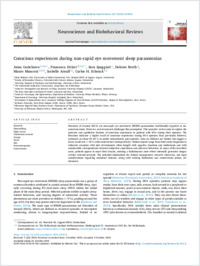Conscious experiences during non-rapid eye movement sleep parasomnias
- Castelnovo, Anna ORCID Sleep Medicine Unit, Neurocenter of Italian Switzerland, Civic Hospital (EOC) of Lugano, Switzerland - Faculty of Biomedical Sciences, Università della Svizzera italiana, Switzerland - University Hospital of Psychiatry and Psychotherapy, University of Bern, Switzerland
- Siclari, Francesca The Netherlands Institute for Neuroscience, Amsterdam, the Netherlands - Center for Investigation and Research on Sleep, Lausanne University Hospital (CHUV), Lausanne, Switzerland - The Sense Innovation and Research Center, Lausanne and Sion, Switzerland
- Spaggiari, Sara Sleep Medicine Unit, Neurocenter of Italian Switzerland, Civic Hospital (EOC) of Lugano, Switzerland
- Borth, Dolores Center for Narcolepsy and Hypersomnias, Department of Medicine, University Witten/Herdecke, Germany h
- Manconi, Mauro ORCID Sleep Medicine Unit, Neurocenter of Italian Switzerland, Civic Hospital (EOC) of Lugano, Switzerland - Faculty of Biomedical Sciences, Università della Svizzera italiana, Switzerland - Department of Neurology, University Hospital, Inselspital, Bern, Switzerland
- Arnulf, Isabelle Narcolepsies et Hypersomnies rares, Assistance Publique-Hôpitaux de Paris-Sorbonne (AP-HP-Sorbonne), Hôpital la Pitié-Salpêtrière, France - Sorbonne University, Paris Brain Institute (ICM), Inserm, CNRS, France
- Schenck, Carlos H. Minnesota Regional Sleep Disorders Center, Departments of Psychiatry, Hennepin County Medical Center, USA - University of Minnesota Medical School, Minneapolis, USA
- 2024
Published in:
- Neuroscience and Biobehavioral Reviews. - 2024, vol. 167, p. 105919
English
Disorders of Arousal (DOA) are non-rapid eye movement (NREM) parasomnias traditionally regarded as unconscious states. However, recent research challenges this assumption. This narrative review aims to explore the presence and qualitative features of conscious experiences in patients with DOA during their episodes. The literature indicates a higher recall of conscious experiences during DOA episodes than previously believed, estimated at about 50–60 % in adults (immediately post-episode). Data on children are limited but suggest a lower recall rate (<30 % when interviewed retrospectively). Patient reports range from brief scenic fragments to elaborate scenarios with plot development, often fraught with negative emotions and misfortunes and with considerable correspondence between subjective experiences and observed behaviors. In many of the described cases, patients appear to enact their dreams, entering a hallucinatory state where internally generated images overlay external percepts. The potential implications for clinical management, research endeavors, and legal considerations regarding nocturnal violence, along with existing limitations and controversial points, are discussed.
- Collections
- Language
-
- English
- Classification
- Medicine
- License
- Open access status
- hybrid
- Identifiers
-
- DOI 10.1016/j.neubiorev.2024.105919
- ARK ark:/12658/srd1331182
- Persistent URL
- https://n2t.net/ark:/12658/srd1331182
Statistics
Document views: 46
File downloads:
- Castelnovo_2024_Elsevier_Neuro biobehav rev_Conscious experiences during: 27
